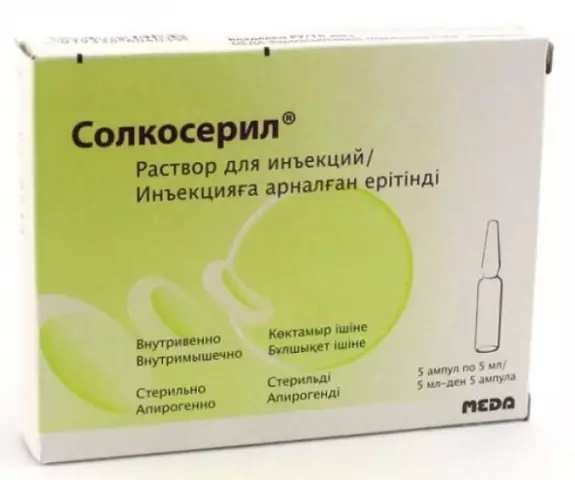- Author Rachel Wainwright [email protected].
- Public 2023-12-15 07:39.
- Last modified 2025-11-02 20:14.
Phenazide
Phenazide: instructions for use and reviews
- 1. Release form and composition
- 2. Pharmacological properties
- 3. Indications for use
- 4. Contraindications
- 5. Method of application and dosage
- 6. Side effects
- 7. Overdose
- 8. Special instructions
- 9. Application during pregnancy and lactation
- 10. Use in childhood
- 11. Drug interactions
- 12. Analogs
- 13. Terms and conditions of storage
- 14. Terms of dispensing from pharmacies
- 15. Reviews
- 16. Price in pharmacies
Latin name: Fenazid
ATX code: J04AK
Active ingredient: isonicotinoylhydrazine iron sulfate (isonicotinoylhydrazini ferri sulfas)
Producer: FARMSINTEZ, JSC (Russia)
Description and photo updated: 2018-23-11

Phenazid is an anti-tuberculosis drug.
Release form and composition
Phenazide is available in the form of tablets: flat-cylindrical, with a dividing line and a chamfer, yellowish-brown color, there are structural inclusions (10 pcs. In blisters, 5 packs in a cardboard box; 50 pcs. In polymer cans, in a cardboard box 1 bank; 500 pcs. in polymer cans).
1 tablet contains:
- active substance: isonicotinoylhydrazine ferrous sulfate dihydrate - 250 mg;
- auxiliary components: calcium stearate monohydrate, potato starch.
Pharmacological properties
Pharmacodynamics
Phenazide is a chelate complex of isoniazid with ferrous iron, is a derivative of isonicotinic acid hydrazide (GINA). The drug has an anti-tuberculosis effect, showing activity against mycobacterium tuberculosis. The pharmacological effect of the drug provides chemotherapy for tuberculosis. It is due to the fact that the isoniazid molecule is modified by complexation with iron. As a result of blocking with iron, the chelate site of the GINK molecule loses its ability to interact with the active centers of metal-containing enzymes, and the interaction with N-acetyltransferase is prevented by the inclusion of the primary amino group of hydrazine in the chelate cycle of the complex.
Phenazide has low toxicity, therefore, the rate of acetylation during use is not a basis for adjusting single and course doses.
Pharmacokinetics
After oral administration, absorption of the active substance occurs slowly, the maximum concentration of the drug in the blood is reached after 5-6 hours.
The half-life is 7.2 hours.
Indications for use
According to the instructions, Phenazide is used as part of the complex therapy of tuberculosis of various localization, including patients with poor tolerance to GINK drugs, concomitant diseases of the central nervous system and liver.
Contraindications
- dysfunction of the thyroid gland;
- cardiac ischemia;
- pulmonary heart failure;
- violation of blood clotting;
- period of pregnancy;
- breast-feeding;
- childhood;
- hypersensitivity to drug components.
Instructions for the use of Phenazide: method and dosage
Phenazid tablets are taken orally, after meals (after 30-40 minutes).
Recommended dosage: to determine individual tolerance on the first day - 1 pc. (With 250 mg) in the morning. In the absence of hypersensitivity reactions, then take 1 pc. 2 times a day (morning and evening). The duration of the course of treatment is 180 days.
Side effects
- from the central nervous system: headache;
- on the part of the cardiovascular system: possibly - cardiotoxic effect, myocarditis, acceleration of thrombus formation;
- from the digestive system: dyspepsia;
- from the endocrine system: hypofunction of the thyroid gland;
- from the side of metabolism: hemosiderosis of parenchymal organs.
Overdose
Symptoms: aggravation of side effects.
Treatment: there is no specific antidote. Immediate gastric lavage, the appointment of symptomatic therapy.
special instructions
The use of Phenazide should be accompanied by regular (at least 1 time per month) carrying out a comprehensive analysis of blood coagulation and electrocardiography.
Application during pregnancy and lactation
The use of the drug during gestation and lactation is contraindicated.
Pediatric use
The appointment of the drug for the treatment of patients in childhood is contraindicated.
Drug interactions
The simultaneous use of isoniazid is contraindicated.
Analogs
Analogs of Phenazide are: Protomid, Pizina, Makox, Rifampicin, Kanamycin, Ethionamide, Ethambutol, Rifampicin, Isoniazid, Kanamycin.
Terms and conditions of storage
Keep out of the reach of children.
Store at temperatures up to 25 ° C, protected from moisture and light.
The shelf life is 3 years.
Terms of dispensing from pharmacies
Dispensed by prescription.
Reviews about Phenazide
The few reviews about Phenazide are positive. The most common side effects of patients include headache and nausea. To avoid undesirable effects, it is recommended to strictly observe the interval between taking the pill and eating.
The price of Phenazide in pharmacies
The price of Phenazide for a package containing 50 tablets can range from 840 rubles.

Anna Kozlova Medical journalist About the author
Education: Rostov State Medical University, specialty "General Medicine".
Information about the drug is generalized, provided for informational purposes only and does not replace the official instructions. Self-medication is hazardous to health!






